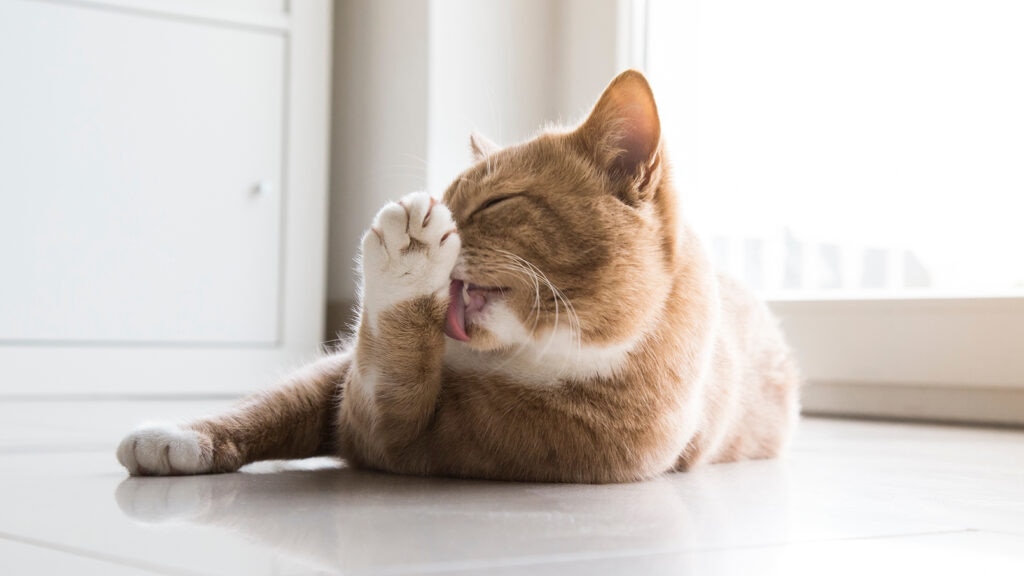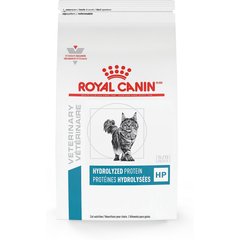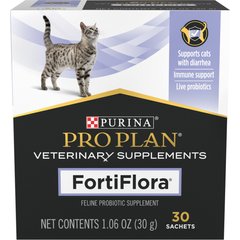What Are Food Allergies in Cats? What Are the Signs?

Photo by Nektarstock/iStock/Getty Images Plus
Just like humans, cats can have food allergies—but diagnosing them isn’t always easy.
Unlike the dramatic reactions we sometimes see in people, food allergies in cats often appear as chronic itchiness or digestive issues, which can be easily mistaken for other conditions like fleas or inflammatory bowel disease.
We spoke to two veterinarians to understand the basics of food allergies in cats, including what causes them, how they show up, how they’re diagnosed, and how to help your kitty find relief.
If you notice any unusual symptoms in your cat, consult your veterinarian.
What Are Food Allergies in Cats?
A food allergy in cats occurs when a cat’s immune system mistakenly identifies a specific ingredient in their diet as a threat and mounts an inflammatory response.
For a cat to develop an allergy to an ingredient, they must have eaten it before—it’s not something that happens the first time they try it.
Food allergies in cats are relatively uncommon. They’re estimated to affect about 1% of all dogs and cats, and up to 15% of cats with itching also have vomiting and diarrhea.
Food Allergies vs. Food Intolerances
Food allergies are not the same as food intolerances, which don’t involve the immune system and can occur at any time (on the first exposure or later).
What Foods Are Associated With Cat Food Allergies?
Food allergies in cats can show up at any point in their life, even if they’ve been eating the same diet for years without a problem.
Most food allergies stem from an abnormal immune response to proteins in food, explains Sarah Cortright, DVM, a veterinarian at Paw Sweet Paw in Irvine, California.
Although any ingredient can potentially trigger an allergy, some foods are more frequently associated with cat allergies. Common cat food allergies include:
- Beef
- Fish
- Chicken
Less commonly, a cat may develop an allergy to ingredients such as:
What Are the Signs of Food Allergies in Cats?
Symptoms of food allergies in cats most commonly appear as skin issues, but they can also affect the digestive system. Here are some common signs to watch for:
- Persistent scratching
- Chewing or biting at the skin
- Over-grooming or licking certain areas obsessively
- Hair loss or bald patches (due to scratching, biting, and licking)
- Red, inflamed, or scabbed skin
- Vomiting
- Diarrhea or soft stools
- Gas
If you notice any of these symptoms, especially if they’re ongoing or worsening, bring your kitty to the vet for a checkup.
What Causes Food Allergies in Cats?
At their core, food allergies occur when a cat’s immune system mistakenly identifies a harmless protein as a threat, Dr. Cortright explains. However, what causes this immune system dysfunction isn’t fully understood.
According to Dr. Cortright, the following factors could be at play:
How Do Vets Diagnose Food Allergies in Cats?
Because food allergies can mimic other conditions, diagnosis often involves a process of elimination. Here’s how vets typically approach it.
Medical History
A vet will typically start by asking about your cat’s symptoms, diet, and past reactions to food.
Physical Exam
Next, your vet will look for other possible causes of your cat’s symptoms, such as skin infections, fleas, or underlying digestive disorders. They might run tests to rule out other health conditions.
Elimination Diet Trial
If no clear cause of your cat’s symptoms is found, your vet will likely recommend an elimination diet trial, which is considered the gold standard for diagnosing food allergies.
This involves feeding your cat a special diet made with a novel protein (something they’ve never eaten before) for eight to 12 weeks, Dr. Cortright explains.
“The cat cannot consume any other food, including treats, flavored medications, or table scraps, during the trial,” she adds.
Veterinary Diets
Veterinary diets (also known as prescription diets or therapeutic diets) are typically recommended for elimination diet trials because they’re made with stricter quality control and are less likely to contain trace proteins from cross-contamination. The specific food recommended for your cat will depend on the suspected allergen.
Hydrolyzed Diets for Elimination Trials
Alternatively, your vet might prescribe a hydrolyzed diet for the elimination trial. These diets contain proteins that are broken down into very small fragments, making them less likely to trigger an immune response.
Vet-recommended hydrolyzed diet cat foods include:
Recommended Products
If symptoms improve during the trial, it’s a strong indication that a food allergy is the cause.
Note: While there are several over-the-counter tests available that claim to diagnose food allergies in cats, Dr. Cortright warns that none have been proven reliable in clinical studies.
Food Reintroduction
While optional, reintroducing the suspected allergen can help confirm the allergy. If symptoms return, Dr. Cortright says this confirms the presence of a food allergy.
As for treatment, food allergies don’t typically go away, but they can be well-managed by avoiding the trigger, says Chris Anderson, DVM, veterinarian at Santa Fe Animal Hospital in Santa Fe, New Mexico.
So, if your cat is allergic to chicken, you’ll need to keep that ingredient out of all their food, treats, medications, and supplements—and continue to feed the therapeutic or hydrolyzed diet prescribed by your veterinarian.
How Can I Help Manage My Cat’s Food Allergy at Home?
Managing a food allergy in cats requires attention to detail and consistency. Here are some ways you can support your cat’s health and help reduce flare-ups.
Stick to Their Prescribed Diet
Because food allergies don’t resolve over time, your cat will need to avoid the allergy-inducing ingredient for their lifetime.
If you’re thinking about switching your cat’s food, talk to your vet first to make sure the new option is safe and appropriate for your cat’s needs.
Check Ingredients
Get in the habit of reading ingredient labels carefully. Always check what’s in your cat’s food, treats, medications, and supplements—because even tiny amounts of an allergen can cause a reaction.
When in doubt, ask your veterinarian or contact the manufacturer to make sure there isn’t a chance of cross contamination.
Prevent Cross-Contamination
Wash food bowls, measuring cups, and prep surfaces thoroughly to avoid accidental exposure to allergens.
Keep a Symptom Diary
Make note of any flare-ups, what your cat ate, and what symptoms they experienced. This can help your vet fine-tune their treatment plan if needed.
How Can I Prevent Food Allergies in My Cat?
Dr. Anderson says there’s no surefire way to prevent food allergies in cats. However, there are a few steps you can take to reduce the risk.
Support Gut Health
A healthy gut supports immune function, and research suggests it could lower the risk of allergies and improve allergy symptoms.
Ask your vet about adding a probiotic supplement, such as Purina Pro Plan FortiFlora, to your cat’s routine.
Recommended Product
Visit Your Vet Regularly for Checkups
Regular vet visits can help catch early signs of food allergies. Your vet can also guide you on the best diet and preventive care for your cat’s individual needs.
FAQs About Food Allergies in Cats
Q: Can cats develop food allergies later in life?
A: Yes, cats can develop food allergies at any age, even if they’ve been eating the same food for years without any problems.
Q: What ingredient in cat food causes allergies?
A: A cat can have an allergy to any ingredient in cat food, but proteins like chicken or beef trigger most food allergies in cats.
Q: What is the most common food allergy in cats?
A: Chicken, beef, and fish are the most frequently reported food allergens in cats. These proteins are commonly used in cat foods, which might increase the likelihood of sensitization over time.
Attributions
This content was medically reviewed by Jo Cornett, DVM, Chewy veterinarian.








